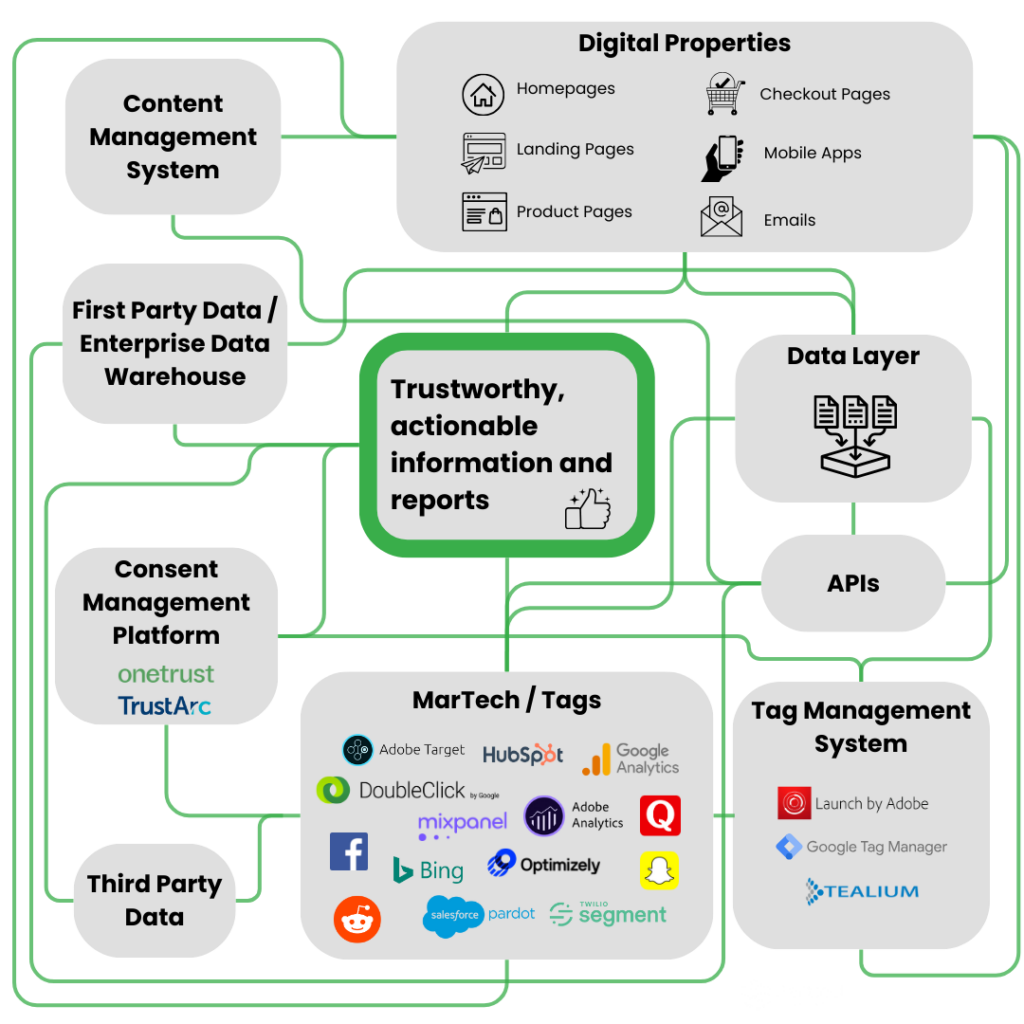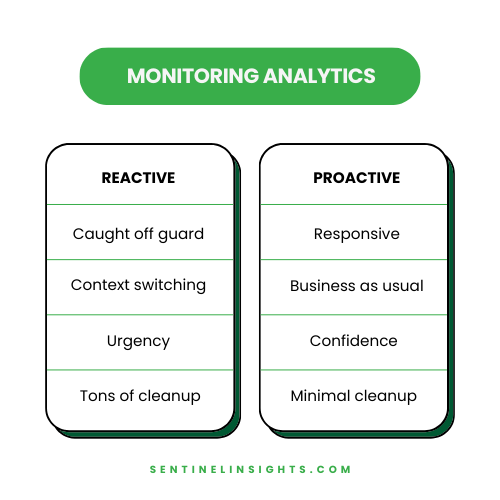As we all know, digital analytics are a major influence in strategic decisions within a data-driven marketing organization. However, maintaining accurate and reliable analytics is an ongoing challenge for many organizations who rely on the data to execute advanced marketing use cases. So this begs the question: how can organizations stay on top of their digital data more effectively? It all comes down to MarTech monitoring.
What Are Digital Analytics?
A digital analytics practice involves collecting, measuring, analyzing, visualizing, and interpreting data from a variety of digital sources. These sources include websites, mobile applications, social media platforms, ecommerce transactions, and digital advertising services. Data from these sources provides comprehensive insights into user behavior, such as how users interact with online content, what paths they take within a digital ecosystem, and their responses to marketing campaigns.
Additionally, organizations compile data from customer relationship management (CRM) systems and email marketing tools to gain a more complete view of customer engagement across various touchpoints. This data helps marketers understand user behavior, optimize campaigns, and enhance user experiences.
Why Data Quality Matters
High-quality data is the cornerstone of informed decision-making. It must be accurate, complete, timely, and consistent to effectively support marketing strategies. Digital data can enable companies to accurately profile customer behaviors, predict market trends, optimize operational processes, and customize marketing efforts to better meet consumer needs.
On the other hand, poor data quality — data with errors such as incorrect information, duplications, or incomplete datasets — can lead to a wide range of problems. First and foremost, data inaccuracies can keep you from making sound strategic decisions. This, in turn, results in costly errors such as misallocated resources, misguided marketing strategies, and lost revenue opportunities. For example, if a million-dollar digital marketing campaign bases its audience targeting on flawed data, the campaign will fail to reach its intended audience efficiently. This means not only that the campaign hasn’t been sent to the right people, resulting in fewer sales, but you’ve also wasted a ton of money to send it to the wrong people. It’s a double whammy of sunk costs.
Therefore, maintaining data integrity through rigorous monitoring and continuous refinement is essential. Organizations that prioritize data quality can:
- Navigate complex markets more effectively
- Adapt to consumer needs swiftly
- Waste less money (in lost sales, tooling expenses, and resource costs!)
- Retain better employee and customer satisfaction
- Maintain a competitive edge
 Image: MarTech stacks are complex, and a data issue anywhere causes problems everywhere.
Image: MarTech stacks are complex, and a data issue anywhere causes problems everywhere.
Challenges in Achieving Data Governance
Effective data governance isn’t easy, nor is it something you can do once and forget about it. It is a multifaceted, ongoing task to manage data availability, usability, integrity, and security.
The wide variety of data sources and stakeholders within an organization complicates the governance process, often leading to data silos where information is isolated and inaccessible to other parts of the organization. These silos hinder comprehensive data analysis and can foster inconsistent governance practices as different departments may adopt divergent data management standards and policies.
In these environments, high-quality data management is often a significant challenge in digital marketing analytics. Overcoming these challenges requires a robust governance strategy that not only breaks down silos but also standardizes data collection practices across the organization to ensure consistency and reliability in the data.
The Strategic Advantage of Proactive Analytics Monitoring
Many organizations opt for auditing tools to understand their analytics implementation. While auditing does have its place in data governance, it is not as effective in other areas of the business that rely on ongoing monitoring. For more about the difference between auditing and monitoring, this article from Compliance.com explains it nicely. It is incumbent on operations teams to ensure monitoring is in place. It’s also important that regular audits are in place to ensure that monitoring is working properly.
For MarTech specifically, monitoring analytics at the point of data collection is the most effective tactic for maintaining data quality. These real-time checks are done as data enters the system rather than in downstream reports or databases. When organizations are able to quickly identify and resolve discrepancies (mismatches, missing values, or unexpected data patterns, for example), they can stop the problems from cascading too far through their data pipelines.
This proactive approach speeds up the time it takes to fix issues, but it has other benefits as well. Clear and prompt issue notification helps teams understand the reasons behind data anomalies, which can help teams prioritize improvements in data collection methods. This leads to a more robust architecture and fewer problems in the future.
Real-time monitoring at the source also significantly reduces the need for extensive post-collection data cleansing, a process that can be costly, time-consuming, and resource-intensive. Cleaning data after it has been integrated into the database or used in reports can lead to significant delays in decision-making and analysis. Worse, it consumes valuable resources (read: human beings) that would be better served performing strategic analysis or innovation-oriented work. Weeks spent doing tedious data cleansing work is not the way to make your best MarTech engineers happy.
Did you know that cleaning PII from analytics vendor systems can cost upwards of $100,000? Or worse, require the removal of entire segments of historical (non-PII) data? It’s true.
Additionally, by ensuring data integrity from the start, companies avoid the risks with making decisions based on flawed data – wasting money, time, and energy marketing the wrong message to the wrong people at the wrong time.
 Benefits of Real-Time Analytics Monitoring
Benefits of Real-Time Analytics Monitoring
Immediate insights into data collection errors are crucial for maintaining the integrity of your analytics program. By implementing systems that provide real-time feedback on the quality of data being collected, you can quickly identify and rectify errors. This might include discrepancies in data formats, unexpected data values, or breaches in data completeness. The issues may be apparent on all webpages or only on a subset.
Real-time monitoring is the only way you’re able to determine quickly and easily what’s going wrong and where the issues are happening. This means that you can fix it quickly and get back to more valuable work.
This real-time monitoring approach ensures that analytics reports and the resulting business decisions are based on accurate and timely data. For instance, you can adjust campaign content to better personalize to a specific audience, correct forecasting errors before they affect projections, and train AI tools to automate some of the manual work. All of this is possible with reliable real-time data.
Tools and Technologies for Effective Analytics Monitoring
Fortunately, several tools are available to assist organizations in monitoring their analytics implementations. Many analytics platforms include features such as automated error detection, real-time alerts, and comprehensive dashboards. However, this level of detail is only available for that specific MarTech vendor. What can you do if you rely on multiple tools or vendors to provide a complete picture of your marketing data?
Sentinel Insights offers cutting-edge solutions designed for real-time data quality monitoring across all of your marketing technologies. The vendor-neutral Sentinel platform has been built with MarTech teams in mind to preemptively identify issues and discrepancies at the time the data is generated by the user.
The platform includes:
- Best Practice Insights – know at a glance whether or not you’ve implemented marketing technologies in accordance with best practices
- Consent Validation Insights – instant alerts when marketing technologies are collecting data in violation of any user’s specific consent preferences
- Anomaly Detection Insights – be the first to know when unexpected data is collected throughout your website
And best of all? The Sentinel Insights platform is continually growing as MarTech tools and strategies evolve.
Maintaining Analytics Accuracy
To effectively manage their analytics implementations, organizations must engage in continuous monitoring and regular updates to their analytics setups. This includes:
- Adapting to new data privacy regulations
- Tackling the increasing complexity of user interactions on digital platforms
- Managing the sheer volume of data the MarTech stack is processing
Organizations often struggle with maintaining the pace of technological advancements and regulatory changes. Monitoring tools like Sentinel Insights automate allow them to focus more on strategic decisions rather than stumbling through operational challenges.
The Critical Role of Monitoring Analytics
The number of MarTech tools is growing and there are no signs of it slowing down. This means that monitoring analytics is a requirement for a modern digital marketing stack. Marketing teams need to invest in the right tools and adopt a proactive approach to MarTech data management. Doing so, they can ensure the quality of their data and derive meaningful, actionable insights. Through proactive monitoring with sophisticated tools like Sentinel Insights, companies can transform potential data-driven challenges into cost savings, opportunities for growth and innovation, and morale boosts for the folks responsible for data collection.
Interested in learning more? Reach out and we’ll show you how Sentinel Insights can help create a foundation of trustworthy digital data.





